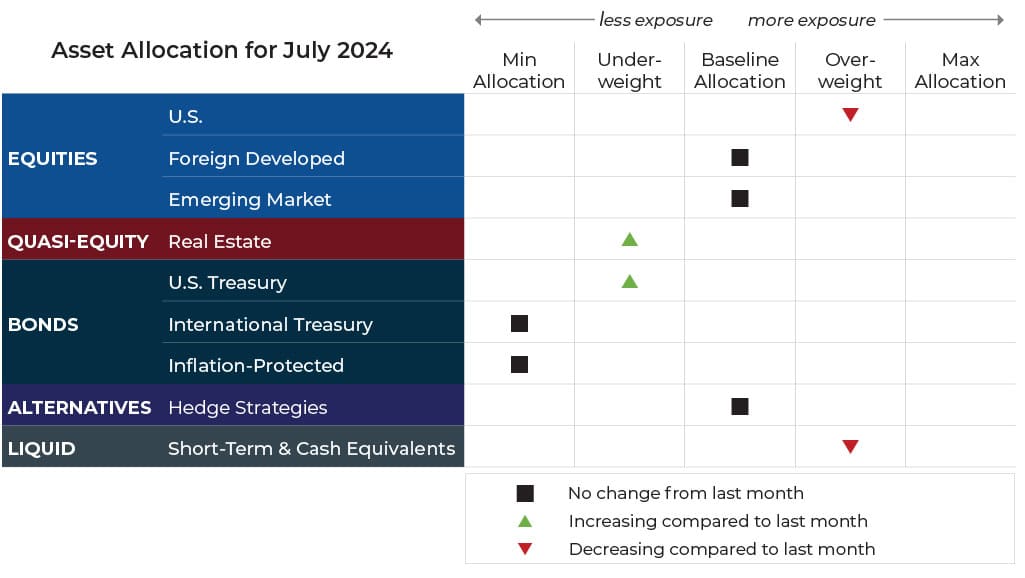Surf’s Up! Why We’re Paddling Into the Waves
“Investing should be more like watching paint dry or watching grass grow. If you want excitement, take $800 and go to Las Vegas.” – Paul Samuelson
We are frequently asked whether we are optimistic or pessimistic about the markets, the economy, the state of the U.S. in general, etc. These are reasonable questions, but they miss the essence of our approach. At Spartan, our investing process, which is predicated on trend following, doesn’t hinge on whether we view the market with optimism or pessimism. Instead, it is rooted in discipline and consistency.
In fact, we believe an emotional attachment to markets — whether via optimism, pessimism, predictions, or any other judgments — is counterproductive and can lead to subjective, ego-driven decisions. Trend following is not about making bold predictions or catching the waves of market sentiment. It’s about having a clear, adaptable plan that can be applied regardless of market conditions. This systematic approach allows us to respond to both the highs and the lows without being swayed by emotional impulses. Put another way, you have probably heard our frequent saying, “We are ready for the what ifs but only respond to the what is.”
In June, for example, we saw the persistence of certain outliers that could cause many investors to make rash decisions if they don’t follow a systematic plan:
- The S&P 500 and artificial intelligence stocks reached new highs
- The Japanese Yen hit 30-year lows
- Large-cap versus small-cap divergences were pronounced
Despite various forecasts and sentiments, a trend-following approach inherently ignores the emotional charges of these movements and only reacts to the data.
Trend following is not about predicting outcomes but about maintaining a disciplined process. By adhering to a disciplined strategy, we can take decisive action without second-guessing ourselves or trying to parse someone else’s motivations or judgments. Yes, it can be boring, and we don’t always have a keep-you-on-the-edge-of-your-seats “story.” In fact, we are far more focused on consistency and repeatability than narrative.
In this month’s note, we discuss in greater detail the active outliers occurring in today’s market environment. We compare a traditional portfolio management approach to our systematic trend-following strategy in terms of capturing these outliers. As part of our comparison, we talk about how, to catch the big waves, you sometimes have to paddle for the smaller ones that look promising but don’t always swell up.
But first, here’s a summary of our take on what transpired in the markets heading into July.
Sourcing for this section: Reuters.com, “S&P 500, Nasdaq hit record closing highs ahead of data, Fed comments,” 6/17/2024; Barchart.com, “The Nasdaq Just Notched Another All-Time High, and Cathie Wood Thinks This Artificial Intelligence (AI) Stock Could Soar Another 1,300%,” 6/27/2024; and Finimize.com, “Yen Hits 38-Year Low, Japan Bond Yields Climb Higher,” 6/27/2024

Disclaimer: This note is for general update purposes related to the general strategy and approach of Spartan Planning portfolios. Every client’s situation including Risk Profile, Time Horizon, Contributions, and Distributions is different from other clients. Your exposure to any given asset class will depend on your goals, risk profile, and how tactical or static your risk profile calls for. Adjustments can vary across strategies depending on each strategy’s objectives. What’s illustrated above most clearly reflects allocation adjustments for the Growth Strategy. If there have been changes to your risk profile and/or goals or if you wish to discuss them in more depth, please contact your advisor.
ASSET-LEVEL OVERVIEW
Equities & Real Estate
By most objective measures, the S&P 500 Index (market-cap weighted) is enjoying a great year. As we hit the halfway point of 2024, this is where we stand with the benchmark index:
- Up almost 15% year-to-date
- Increasing in five of six months this year
- Increasing in seven of the last eight months overall
With that said, it doesn’t take a deep dive to notice some wide disparities within the index and across U.S. stocks more broadly:
- Even among large-cap stock indexes, performance has varied wildly. For example, the Dow Jones Industrial Average is up only about 4% year to date (YTD).
- Value and dividend stocks are faring better YTD but only providing roughly half the return of the S&P 500 Index.
- Mid- and small-cap performance YTD is underwhelming. The former is up around 5% and the latter has increased less than 3%.
- While the market-cap-weighted S&P 500 is up almost 15%, an equal-weighted measure of the same index changes the scenario to one that is up less than 5%.
Despite the variety, all segments noted above remain in uptrends. Consequently, our portfolios will remain overweight U.S. equities, particularly large- and mega-cap stocks.
Our portfolios will also remain steady for foreign developed and emerging markets. Emerging markets have surpassed their developed market counterparts for the year, but both continue to perform more like value and income stocks in the U.S. than growth stocks.
Real estate securities remain among the weakest equity-like instruments, even after a slightly positive June. These assets remain depressed by higher interest rates and continue to be in the red for 2024 thus far. That said, the intermediate-term trend has turned positive, and thus our portfolios will reflect a tiny increase in exposure. If this segment remains relatively weaker than other U.S. equity segments, any allocation increases will be capped.
Fixed Income
Like real estate, government bonds — particularly those in the U.S. — will see a slight uptick in exposure in our portfolios due to the return of an intermediate-term uptrend. The allocation increase will be relatively minor but sets the stage for more increases if trends continue to materialize. In our opinion, one of the biggest benefits of trend following is the ability to gain exposure early to an overlooked asset without taking material risk. We see July’s increased duration exposure as a potential example of that.
Sourcing for this section: Barchart.com, S&P 500 Index ($SPX), 11/1/2023 to 6/27/2024; Barchart.com, Dow Jones Industrials Average ($DOWI), 1/1/2024 to 6/27/2024; Barchart.com, Value ETF Vanguard (VTV), 1/1/2024 to 6/27/2024; Barchart.com, High Dividend Yield Vanguard ETF (VYM), 1/1/2024 to 6/27/2024; Barchart.com, Midcap ETF Vanguard (VO), 1/1/2024 to 6/27/2024; Barchart.com, Smallcap ETF Vanguard (VB), 1/1/2024 to 6/27/2024; Barchart.com, “S&P 500 EW Invesco ETF (RSP), 1/1/2024 to 6/27/2024; Barchart.com, FTSE EM ETF Vanguard (VWO), 1/1/2024 to 6/27/2024; and Barchart.com, FTSE All-World Ex-US ETF Vanguard (VEU), 1/1/2024 to 6/27/2024
Three potential catalysts for trend changes:
-
Record Highs: Home prices rose in May to another new high. The national median price for an existing home was $419,300, a record in data that goes back to 1999.
-
Rent Hikes: Apartment rents in several Northeast and Midwest cities, such as Kansas City, MO, and Washington, DC, are beginning to rise this year. Shelter inflation, which is mostly a measure of rents that lags market conditions by a few months, was high in May, with an annual rate of 5.4%.
-
Slowing Spending: American shoppers increased spending in May, but not as much as economists had forecast. Excluding autos, retail sales slipped 0.1% from the previous month, whereas economists had expected a 0.2% gain. Additionally, April’s report was revised lower to a 0.2% decrease, whereas the previous reading had said sales were unchanged from the prior month. Retail spending accounts for roughly two-thirds of GDP, so it is an important health indicator of the economy.
Sourcing for this section: The Wall Street Journal, “Home Prices Hit a Record High,” 6/21/2024; The Wall Street Journal, “Rent Hikes Loom, Posing Threat to Inflation Fight,” 6/18/2024; The Wall Street Journal, “U.S. Retail Sales Rise Less Than Expected in May,” 6/18/2024; and FRED Economic Data, “Shares of gross domestic product: Personal consumption expenditures,” Q1 2024
How We Know When to Catch a Wave, And When to Hop Off
“There’s a model that I call ‘surfing’ – when a surfer gets up and catches the wave and just stays there, he can go a long, long time.” – Charlie Munger
The close of spring in the U.S. and the onset of summer usually brings much talk about extreme weather events, from hurricanes to heat waves. Financial markets are another fertile ground for extreme behavior.
It doesn’t take much digging to uncover examples of markets or assets exhibiting movement outside of their accepted norms. Here are a few as we begin July:
- The top five holdings in the S&P 500 now make up 27% of the index, the highest concentration going back to 1980.
- The outperformance of U.S. large caps (S&P 500) over small caps (Russell 2000) is now at its most extreme level since November 24, 1999.
- The outperformance of growth versus value is at its highest level since 2000 (Russell 1000 Growth versus Russell 1000 Value).
In these cases, most traditional methods of portfolio management have little opportunity to adapt to these realities because these events are inherently difficult to predict. The human brain tends to minimize the likelihood of outlier events, especially when using historical data as a guide. At best, a traditional management approach might respond to these extremes by ignoring them, assuming they will neither cause damage nor be worth the upside. At worst — and we believe this is the more typical reaction among the public — an investor might attempt to react on the fly without a tested process, resulting in emotional (i.e., irrational) decision-making.
We believe a strength of a trend-following approach, like ours, is the ability to adapt and respond to extremes. By focusing only on price, our strategies seek to accomplish what Munger illustrated in the quote above: catch even extreme waves and surf them. We do not attempt to predict when or where a wave will occur. Rather, we watch the behavior of the waves against our rules, and react quickly when a wave matches our process and enjoy it as long as it lasts, or at least as long as our process deems the wave safe to ride. As soon as the wave breaks our rules, we duck out. We may hold significant exposure for years and then ignore an asset, or we may enter and exit quickly. There is no emotional connection either way. We view all assets simply as instruments to which we apply our rules, to help steward your financial lives and provide for your future goals in what we find to be a more stabilized fashion.
Examples of this approach can be easily illustrated in our current and historical holdings. Today our portfolios continue to be overweight in the general U.S. equity market, but more specifically growth positions, and where possible, the top-weighted stocks in the S&P 500. On the flip side, value, income, real estate, and fixed-income instruments of any duration remain underweight. We are agnostic about the instrument itself but care greatly about how it is used.
Another common saying you have likely heard from us concerning our risk management is “We would rather be consistently good instead of occasionally great.” Continuing the theme of riding waves, we want to spend as much time as we can “hanging ten” and as little time paddling around only looking for waves or getting pummeled by the breakers. By paddling into waves we can ride and look promising based on our process, we believe we can provide a more stable financial future for you to enjoy.
Sourcing for this section: @charliebilello, “S&P 500: Weighting of Top 5 Holdings (1980 – 2024),” 6/23/2024; Bilello.blog, “US Large Cap Domination – Chart of the Day (6/20/24), 6/20/2024; and Bilello.blog, “The Week in Charts (6/23/24),” 6/23/2024
Sincerely,
The Spartan Team

